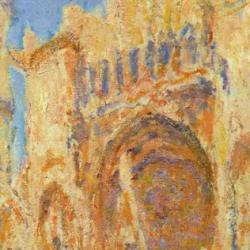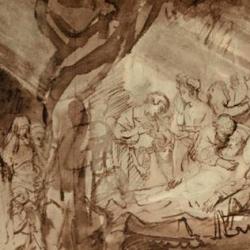Deeana Copeland Klepper, The Insight of Unbelievers: Nicholas of Lyra and Christian Reading of Jewish Text in the Later Middle Ages (Jewish Culture and Contexts) . Philadelphia:University ofPennsylvania Press, 2007.
Modern biblical criticism is the product of Jewish-Christian cooperation. On the one hand, it is a creation of Anti-Calvinist Pietists in theNetherlands. Against the Protestant Orthodox insistence that even the vowel points of the Hebrew text were divinely inspired, pietist Arminians known as Collegiants exalted the spirit over the letter, and their emphasis on the “inner light” of the guiding spirit morphed, as Andrew Fix has shown, into the “inner light” of natural reason. Whether understood as “spirit” or “reason,” the inner light provided a standard by which the letter could be weighed in the balances, and found wanting.
Though Christian in origin, critical reading of Scripture was injected into the bloodstream of European thought through the ministrations of a Jew, Baruch (Benedict) Spinoza. Spinoza himself had close ties with the Dutch Collegiants, and his seminal Tractatus Theologico-Politicus (1670) echoed pietist rhetoric. He complained that for the Calvinist Orthodox, the “impious are not those who point out the contradictions in the Biblical text but those who bludgeon others with their Bibles,” and insisted that the keynote of true religion is not orthodox adherence to dogma or Scripture’s propositions but obedience to the Divine Law of justice and love. While Spinoza advocated a form of the Protestant principle of Scripture interpreting Scripture, ultimately he measured Scripture by ethical and rational standards from elsewhere. Philosophy, not theology should guide ethics, and he found much of the Bible historically absurd, philosophically untenable, and theologically impious.
Given this pedigree, historical critical scholarship could plausibly seize the high ground of ecumenicity: In contrast to the sectarian readings offered by the different sects of Christianity, or by Christians opposed to Jews and Jews opposed to Christians, critical methods promised a truly universal biblical scholarship. Biblical scholars no longer need to be Christians, nor Jews, nor believers of any kind. Historical criticism unites people of all faiths, and none, in the common enterprise accessing the meaning of an influential ancient text, using methods freed from sectarian bias. As many have argued in the last half century, the neutrality of historical criticism is an illusion, as are all claims to neutrality. Spinoza’s methods had an overt religious and political aim, and in adopting the methods of historical criticism, Christian interpreters have (sometimes unwittingly) accepted assumptions about language and textuality, epistemology and politics that run against the grain of Christian tradition.
Nothing marks the difference between critical and premodern interpretation as dramatically as the difference in approach to Jewish interpretation of the Old Testament. That Christian interpreters follow Spinoza – not only Jewish but a highly unorthodox Jew – would have astonished the fathers and medieval interpreters.
Jews, after all, occupy a large and largely negative place in the premodern Christian imagination. Long after the church had stretched out far beyond the boundaries of her Palestinian birthplace, Jews remained the prototypical enemies of the faith. Eusebius was not alone in tracing all early heresies to Simon Magus. As late as the fourth century, Athanasius could level the charge of “Judaizing” at Arius. And he wasn’t the last. Andrew of the famedschoolofSt. Victorcharged his colleague Richard with “Judaizing” because Richard was too uncritical in his use of Jewish sources.
The connections that early theologians draw between Judaism and Christian heresy are often interesting and sometimes plausible, but in the process Christians forged an anti-Jewish rhetoric that ranged from petty to vicious. In a letter sent to bishops after the Council of Nicea, Constantine does not mention Arius, Christ, or homoousios , but takes a good deal of space to celebrate the conciliar consensus on the date of Easter, a consensus whose primary virtue was that it was independent on Jewish time-keeping. It was “unworthy,” the emperor argued, that in the “celebration of this most holy feast we should follow the practice of the Jews” since they “impiously defiled their hands with enormous sin, and are, therefore, deservedly afflicted with blindness of soul.” In general, Christians should avoid “all participation in the perjured conduct of the Jews.”
Particularly when it came to biblical interpretation, the Jews were unreliable. Even Christians who did not accuse Jews of roasting and eating small children denied that Jewish scholars could provide insight into Scripture. After the Talmud was put on trial inParisin 1240, and condemned as heretical, heaps of Jewish books were burned. Pope Innocent IV followed with an exhortation to the French king to find and destroy any that remained. No other European country tried and burned the Talmud, but Dominicans devoted their impressive energies and subtle minds to pile up a large stack of anti-Talmudic tracts.
Vivid stories like the trial of the Talmud make for good copy, but Deeana Klepper’s well researched book demonstrates that some Christian responses were more nuanced than a bonfire. At the very time that the church’s antiJudaism was reaching a peak, the Franciscan Nicholas of Lyra (c. 1270-1349) was developing a carefully nuanced treatment of Jewish interpretation that influenced Christian readers into the early modern period.
One of Lyra’s most important contributions was the Postilla litteralis super Bibliam (1322), a literal commentary on the entire Bible, and he also published a single volume abridgement examining passages where the Vulgate differed from the Hebrew Scriptures. The Postilla was the second most popular commentary on the Bible in the late medieval period, surpassed only by the Glossa ordinaria , with which it often circulated. As late as the seventeenth century, both Protestants and Catholics were still using Nicholas’s commentary, Luther defending his ad fontes translations by appeal to Nicholas’s example. One illuminated manuscript of the Postilla shows Nicholas, smallish and cramped at his desk in the lower right corner, taking notes from a resplendent Jerome who teaches from a podium. Despite subordinating Lyra to Jerome, the illustration is a compliment that visually expresses the common description of Nicholas as a “second Jerome.”
What is most striking about Nicholas’s Postilla is his wide and varied use of Jewish sources. He appealed to the Hebrew Bible directly to challenge Vulgate translations, arguing, for example, that Rahab was not a harlot but an “innkeeper.” At times, he built Christological interpretations of the Old Testament on Jewish sources other than the Hebrew Bible to correct what he claimed were deliberate Jewish alterations of the text. More importantly for Klepper’s book, he drew on the work of Jewish exegetes, especially the eleventh century rabbi Solomon ben Isaac known as Rashi, to clarify literal meaning and sometimes to fill out a Christological allegory. As a re
sult, Lyra’s Postilla became the major Christian conduit for transmitting Jewish exegetical traditions to Christians through the late Middle Ages.
As he was well aware, Nicholas’s use of Jewish tradition raises the complex epistemological question of Jewish unbelief. How can Jews who reject the Messiah who is the res of Scripture have exegetical insight of any kind? The question had been raised in various forms by scholastics for at least two centuries, and one of the most intriguing sections of Klepper’s book reviews some of the work of Nicholas’s predecessors – Roger Bacon, Roger Marston, Peter Olivi. Nicholas himself addresses this issue in his quodlibetal treatise answering the questions “whether the Jews knew Jesus of Nazareth to be the messiah promised to them” and “whether from Scriptures received by the Jews it is possible to prove effectively that our savior was both God and man.”
In answer to the first question, Nicholas surveys the New Testament and concludes that the Jews both knew and did not know Jesus was Messiah. On element of his solution to this apparent contradiction was sociological: The elites ofIsraelrecognized Jesus, but the common people did not. Philosophically, he appealed to the Aristotelian distinction between general and particular knowledge. An intemperate man has a false moral code, but an incontinent man does not practice temperance even though he knows he should. The latter has the right code but fails to act on it. Aristotle identified passion as one of the main obstacles to knowledge, and Nicholas argued that passions so corrupted the knowledge of the Jews that “a temporary ignorance deprived from moral weakness that was distinct from their customary perceptiveness.” It was a neat solution: It allowed Nicholas to stand with the church in condemning Jewish ignorance while leaving him space to employ Jewish interpretive traditions freely.
Besides addressing this epistemological issue, Nicholas wanted to defend the Christian use of Hebrew prophecy, and this was the thrust of his second quodlibetal question. His premise was that a literal interpretation of the Hebrew Bible would yield a Christian interpretation. As Klepper points out, this argument assumes a more flexible notion of “literal” than had existed in the patristic and early medieval period. Instead of arguing for a twofold meaning, literal and spiritual, Nicholas, like some of his contemporaries, argued that a “parabolic” sense is embedded within the literal. When Yahweh identifies Solomon as his son, he is not only literally describing Solomon’s adopted sonship but also, in a parabolic/literal fashion, describing the natural sonship of the Second Person of the Trinity.
On the basis of this hermeneutical theory, Nicholas argues for Christian interpretations of prophecy by attending to the details of the letter. Jeremiah 23:5 on the strictest interpretation promises that the Messiah will himself be divine, and Isaiah 9:6 says quite literally that Yahweh is a child. He concludes that the Jews could have derived the Christian belief in a God-man from their own Scriptures, were they not blinded by passion and envy. Nicholas’s approach has apologetic value. An argument from the letter is likely to be persuasive to Jewish readers than an apparently arbitrary move to a “spiritual” meaning.
No one today longs to return to the days of book-burning and Jew-baiting. Everyone is happy to see as many yarmulkas as clerical collars at meetings of the Society of Biblical Literature. Yet, I am unconvinced that critical scholarship can make the lions lie with the lambs. The usual solutions are far too easy, including the easy brush-away charge of supercessionism. With a wave of the hand, anti-supercesssionism removes the problem of Jewish incredulity about Jesus, and replaces the problem with the happy news that Jews have always been in covenant with God after all.
Surely it matters to our reading of the tabernacle texts whether we believe that the veil is destined to be torn by the final sacrifice of Jesus, or whether we believe that a permanent veil is the genius of biblical religion. Surely we cannot read the beginning and middle in the same manner unless we agree on where the story ends. Nicholas of Lyra’s approach was more honest and more comprehensive: He took seriously both Jewish insight and Jewish unbelief. He has much to teach us, and Klepper’s book shows us once again that we have a long way to go to catch up with the medievals.















